
8 minute read
Clinical
The color gradient of natural teeth and their intelligent imitation
Stefan Roozen1
1 Stefan Roozen, MDT, Laboratory manager & chief technician, Pils Zahntechnik GmbH, Austria His main areas of work are complex prosthetic reconstruction (tooth and implant supported), demanding restorations in the aesthetic and functional area. Introduction Nowadays, more and more monolithic restorations are being made. Around 90% percent of all posterior teeth are ordered in a key shade (for example: Vita A3 or A2). It is no longer necessary to laboriously layer these simple colors. For some time now, lithium disilicate and modern translucent zirconia have made it possible to make them aesthetically enough without great effort, from a single material without veneering. Just mono.
This variant can also be used successfully in the anteriorarea. This is particularly efficient and makes economic sensewhen restoring entire jaws. In case of smaller rehabilitations, however, the surrounding clinical environment requires a more individual approach and the effects of nature should be reproduced to the given extent in order to achieve good integration. Front teeth in particular are extremely multifaceted and can be very different in color and shape. From opaque to transparent, different in chroma and color value, highly dynamic and full of effects in the incisal third.
Therefore, the staining technique can be combined with the newly developed SQIN - the new Initial micro-veneering type of ceramic - in order to achieve the necessary complex depth of natural teeth.
The example of nature The essential color components of the natural tooth are hue, chroma and translucency. - Hue: the base colors. A (red-brown), B (yellow), C (gray) and D (red-gray). (Vita classic shade guide) - Chroma: the saturation of the respective color value. - Translucency: in the translucent area, the light is reflected less and penetrates more through the tooth. This area is therefore also described as an absorbing zone. The color gradient of the tooth (Fig. 1) - The cervical 1/3: mostly with increased chroma of the base color (a) - The central 1/3: base color, area with the highest brightness value (b) - The incisal 1/3: area with increased translucency; absorbent area (c)
Figure1: The color gradient of the tooth: a) increased chroma; b) base color; c) increased translucency Figure 2: The cervical area
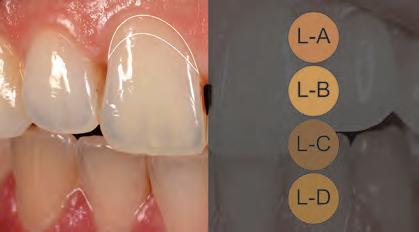
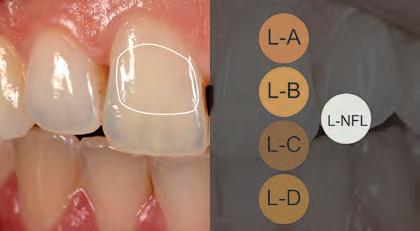
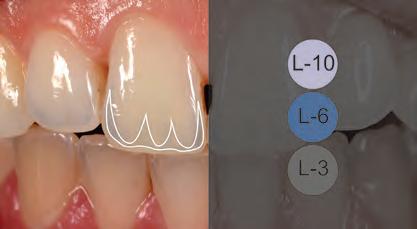
Figure 3: The central third; (L-NFL: Neutral Fluo) Figure 4: The incisal zone; (L-10: Twilight; L-6: Dark Blue; L-3: Dark Grey)
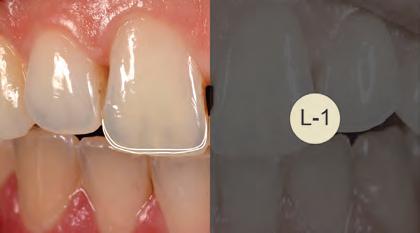
Figure 5: The halo; (L-1: Vanilla)
The imitation and the material The new Lustre Pastes ONE are a further development of the proven Lustre Pastes NF. These natural looking fluorescent glazes are applied to the surface and create a three-dimensional end-result due to the special mixture of fine feldspar based glass ceramic particles. Thanks to its ceramic structure, they are suitable both as finish for monolithic indications and can be used in combination with veneering ceramics (internal and external usage).
The cervical area (Fig. 2) usually has an increased chroma. The corresponding color tone (e.g. L-A) is applied a little more intensively in order to achieve more color saturation.
The central third (Fig. 3) is the area of the actual tooth color. The chroma is checked with L-A, L-B, L-C or L-D according to the target color. These are applied gently so that they let through. They can be used pure for a higher color saturation (e.g. A3.5, A4, B4, C4, ...) or can be softened with L -NFL to achieve a lighter shade (e.g. A1, B1, C1, ...)
The incisal zone (Fig. 4) is imitated with absorbent colors. Bluish, purple and gray pastes (L-10, L-6, L-3, ...) create the illusion of transparency. Alternatively or in combination, a unique Opal paste can be applied. (L-OP).
Other effects such as white spots, cracks or the reproduction of the halo can create additional dynamism and liveliness.
The halo (Fig. 5) is painted on as a bright, shining band.
6 7 8 9 10
Figure 6: Before: Zr crown; Figure 7: Application of Lustre Pastes ONE; Figure 8: After: Finished crown; Figure 9: Before: Zr crown; Figure 10: After: Finished crown
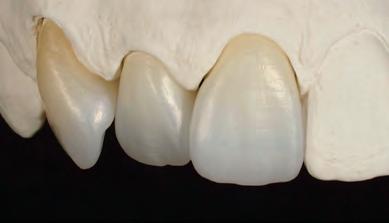
Figure 11: Sintered Zr crowns after firing Figure12: Refined with Lustre Pastes ONE, after firing
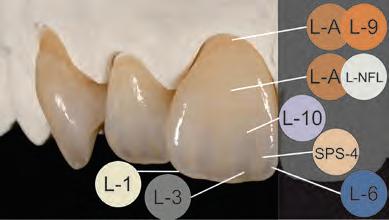
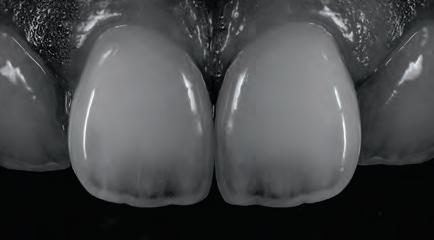
Figure 13: Grayscale image of natural teeth showing the variance in color value throughout the teeth, especially in the incisal third.
This shows the bundling of light on the cutting edge and enhances the transparent effect.
The monolithic implementation
Lithium disilicate and translucent zirconia are mainly used as restorative material nowadays. The fully anatomically shaped crowns are simply glazed and refined in color using the Lustre Pastes ONE.
Lustre Pastes ONE can also be combined with Initial Spectrum Stains (fine ceramic stains), thus offering unlimited color options.
When it comes to key colors, it is often sufficient to use just a few pastes. For example, with this premolar shown in Figs. 6-10, L-A (Lustre Body A) was applied in the appropriate intensity until the desired chroma of the respective A-color was achieved. L-6 (Enamel Effect Dark Blue) was used very discretely on the cusp tips to imitate some translucency. The tooth color is already visible upon the application, even before firing.
The corresponding tooth areas are color-coded for more individuality. The three-dimensional effect of the pastes creates a dynamic result (Figs. 11-12).
The Micro-Layering Upgrade Natural teeth can sometimes have a very complex depth and individuality in their enamel layers (Fig. 13). With the new micro-layering concept - Initial IQ ONE SQIN - a very thin ceramic layer (approx. 0.2-0.3 mm) is

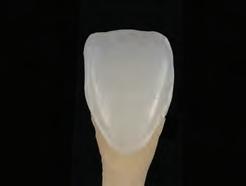
Figure 14: Zr crown, 0.3 mm labial reduction Figure15: Lustre Pastes ONE – coloring and wash fire Fig16: Micro-ceramic layering with Initial SQIN Figure17: Result after firing
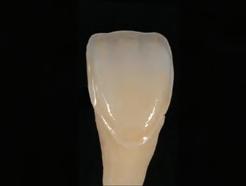
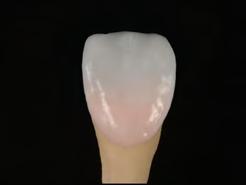
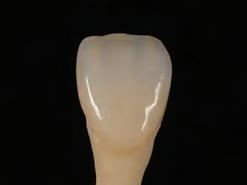
applied on the surfaces that have been previously fired with Lustre Pastes ONE. The end-result is achieved in just one firing. This is made possible thanks to the newly developed feldspar-based SQIN ceramic powders. Using the special mixing liquid (Form & Texture Liquid) the application is very comfortable – easy to form your final shape, easy to mimic texture. After the final, shiny firing result – the so called –“selfglazing effect” is obtained. Due to its high homogeneity, the mass remains very stable during processing and shows hardly any shrinkage after firing, so that shape and texture no longer need to be corrected (Figs. 14-17).
Minimally invasive meets Minimal-Layering With this new micro-layering concept – Initial IQ ONE
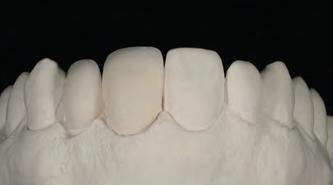
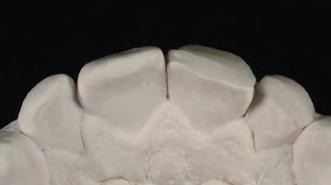

Figures18-20: Initial LiSi Press (LT-B0) veneers with minimal labial reduction
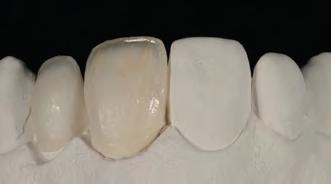
Figure 21: Lustre Pastes ONE Figure 22: SQIN micro-ceramic layer before firing Figure 23: Firing result with “self-glaze” effect of SQIN.

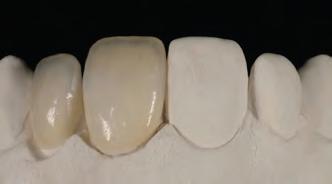

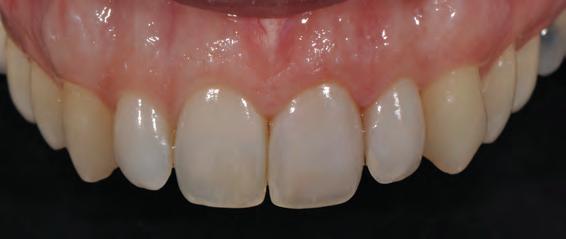
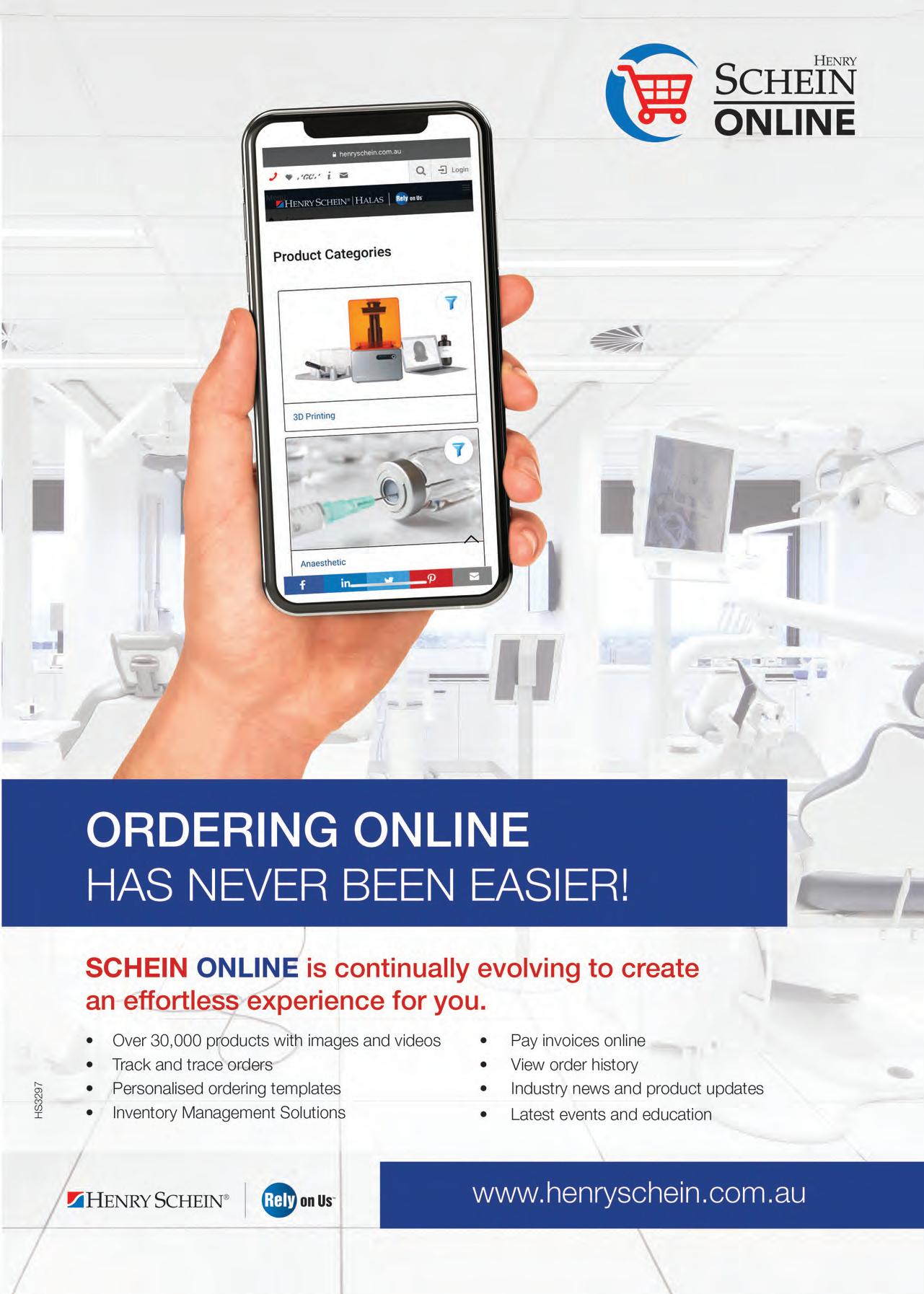
27
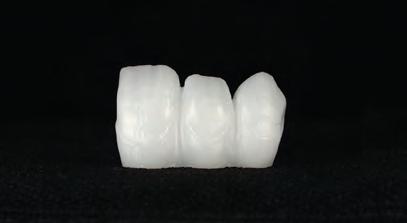
Figure 26: Zirconia structure
28 29

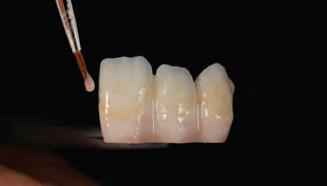
Figure 27-29: Zirconia structure, application of different tooth-colored (Initial Lustre Pastes ONE) and gingiva-colored pastes (Initial Lustre Pastes NF Gum)

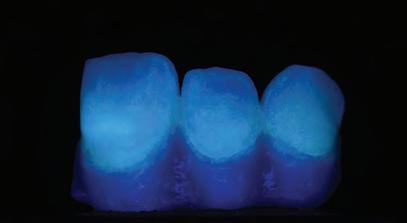
Figure 30: Fluorescence of the white areas, nonfluorescence of the red areas Figure 31: Initial Lustre Pastes ONE after firing

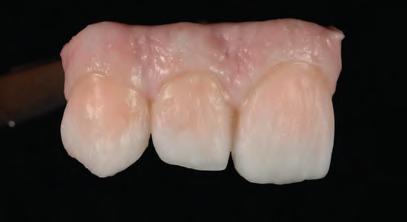
Figure 32: Red and white SQIN ceramics before firing (shaping & texture possibilities!) Figure 33: Result after firing
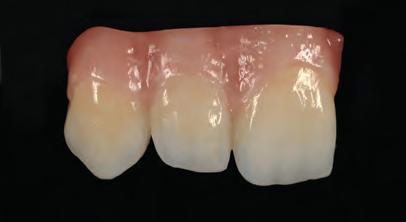
SQIN - a high degree of aesthetics is achieved in the smallest of spaces. As a result, modern treatment methods that are particularly gentle on the tooth structure do not represent a compromise. Small rehabilitations in aesthetically sensitive areas can thus be carried out without great effort (Figs. 1825).



Initial ONE SQIN micro-layering concept
The gingival reconstruction Especially in implantology, we often come across the situation of reconstructing gingiva with our prosthetic superstructures. The red-white gradient deserves special attention. Here, too, the technology of Initial IQ ONE SQIN concept is used. The different gingival regions can be reproduced with three different SQIN gingival powders. A more intense red for areas with strong blood circulation and a lighter shade for the firm gingiva are essential. Furthermore, a neutral type completes the line-up. In contrary to the tooth-shaded SQIN powders, all SQIN gingival powders are inherently non-fluorescent (Fig. 30). The way it works is the same as with tooth-colored ceramics. First, Lustre Pastes ONE and/or Lustre Pastes NF Gum shades are applied to give an ideal color base and create a good bond with the ceramic layer (connection firing). Then SQIN gingiva- and tooth-colored ceramic is applied in a final firing.
Conclusion
The new Initial ONE SQIN microlayering concept - offers a complete range of materials, assuring a high level of aesthetics and reduced working time. It fits to the actual full ceramic market tendency using zirconia and lithium disilicate as base materials. Using minimal veneer thicknesses minimize chipping and fractures, thus avoiding complaints. This technology is compatible with the digital workflow without compromising the individuality of the patient’s wishes, and thus to be successful in the demanding dental market.
Reprinted with permission by GC






